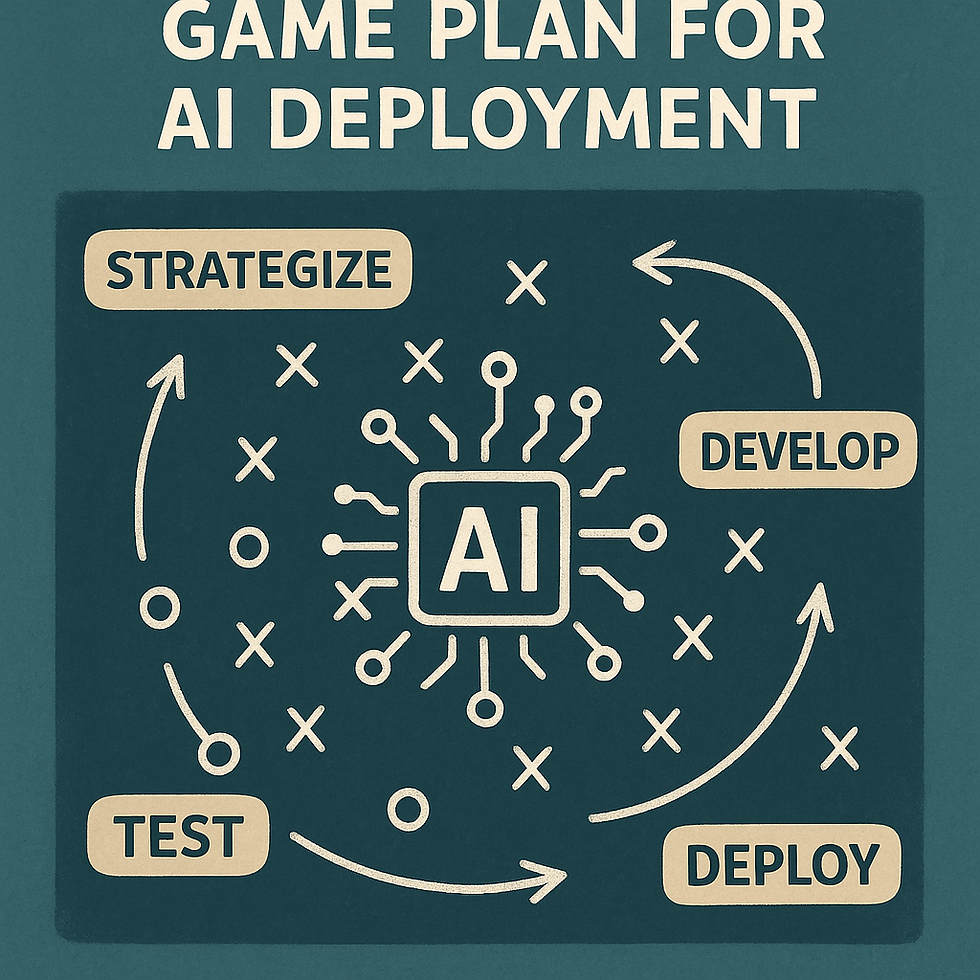Your No-Nonsense Guide to AI for SMB's: the WHERE and HOW to approach the starting line
- Todd Jones
- Aug 15
- 4 min read

Ready SET GO!!! AI isn't the endgame, it's the ride. The real goal? Getting more done, making fewer mistakes, deciding faster, and making customers happy.
For small and mid-sized businesses (SMBs), it's about picking the right problems. Then, you gotta plug AI into what you already have and add just enough rules to grow without a headache. This way, you avoid a messy pile of tools and actually see some real results.
Lots of companies are trying out AI agents and assistants, but they struggle to make them work together across the whole business. This just leads to bits of value instead of big changes. A smart approach is to think about the problem first, then the tools.
Quick breakdown: Assistants vs. Agents
AI assistants are good for repetitive, straightforward tasks.
AI agents are more independent; they think things through to reach a goal, staying within set boundaries.
First things first: Solve a business problem (don't just grab a tool)
Before you go shopping for AI, ask yourself:
Where will AI really make a difference (growth, efficiency, cutting risks)?
Is our data ready for this (good quality, easy to get to, managed well)?
Can our team and processes handle the change?
Do our current systems support safe and scalable AI integration?
Industry pain points AI can fix right now:
Legal: Lawyers spend tons of time on non-billable stuff. AI can help with new client intake, conflict checks, scheduling, and drafting basic documents. Plus, it can help with pressure from clients and rising rates by standardizing things and automating documents.
Insurance: Old systems are slowing things down. AI can help with claims, first notice of loss (FNOL) triage, and underwriting checks, even if it sits on top of older systems.
Financial Planning: So much compliance! AI can pre-check trades, summarize client calls for compliance, and validate disclosures.
Manufacturing: Labor shortages and supply chain drama are a pain. AI can handle maintenance tickets, watch for supplier risks, and help re-plan schedules to avoid downtime.
A good starting point: Pick a task that takes forever and usually has errors, then see how much AI helps. One company cut task time by 25% and errors by 10% by focusing on onboarding and project management.
Second step: Say "yes" to AI—but be smart about it
Most companies already have tons of AI apps (some you might not even know about!). Just adding more without a plan makes things worse.
Create a way for AI to connect with your people, workflows, data, and existing apps. Then, add AI where it really boosts things.
How to choose:
If teams are stuck on repetitive steps, use assistants.
If you need results that involve multiple systems and judgment within rules, go for agents.
Also, train your people! CEOs expect a lot of re-skilling in the next few years, so make sure to include training in any AI rollout.
Third step: Don't let your AI be a loner—connect tech and people
AI works best when it's integrated with everything—your apps, daily routines, and workflows. Many tech leaders aren't ready for this, but it's fixable with the right plan.
Integration checklist for SMBs:
Workflows: Map out how tasks actually flow, and get rid of manual handoffs before you automate.
Humans-in-the-loop: Figure out when people need to approve or overrule AI actions. Keep an eye on how well people adopt it and if there are any "human-machine" clashes.
Guardrails: Set up responsible-AI rules, track everything, use secure connections, and control who can access what from day one.
What good AI looks like: A small collection of assistants and agents working together across HR, finance, operations, and customer service. You'd measure success by how fast things get done, how few errors there are, and how easy it is for customers. Internally, automating smart workflows has gotten rid of most simple tasks and saved a ton of money.
Quick wins by industry (ideas to get started):
Legal: Intake triage, conflict checks, matter setup agents; drafting assistants for standard docs; summarizing hearings/cases; client status updates and invoice explanations.
Insurance: FNOL chat and document capture; automated claim indexing; underwriting validation (loss runs, sanctions, fit); producer helpers for quotes and renewals.
Financial Planning: Compliant call notes with KYC/AML prompts; trade pre-checks and disclosure validation; portfolio review agents that flag issues.
Manufacturing: Predictive maintenance + auto-ticketing and parts lists; supplier risk monitoring; schedule re-planning; quality nonconformance triage with root-cause templates.
How AgentixAI.ai can help you get started fast (and safely):
For SMBs, the difference between "we tried AI" and "AI runs the business" is a structured rollout. AgentixAI.ai can help you:
Do a 2–4 week Discovery & Design Sprint:
Pick 2–3 AI projects with clear goals (like faster task times, fewer errors, or cost per case).
Figure out your data readiness and where AI will connect (like with G Suite/365, CRM, ERP, DMS).
Draft rules for human oversight and compliance for your industry.
Set up a simple orchestration layer:
Connect your existing tools (like n8n/Zapier, ticketing, CRM/ERP) so AI works with them, not as another silo. The goal is fewer tools and better coordination.
Prove ROI in 30–60 days:
Launch one assistant (for a repetitive task) and one agent (for a cross-system outcome).
Track everything; publish before-and-after dashboards and adoption stats.
Train your team:
Give short, specific training to case handlers, adjusters, advisors, schedulers, and supervisors so the AI wins stick around.
Last thought:
Winning with AI isn't about collecting a bunch of fancy models. It's about picking the right problems, making your existing tools work together, and keeping your people in the loop. Do that, and your small AI experiments will turn into big, ongoing gains, no matter your industry or size.
.png)




Comments